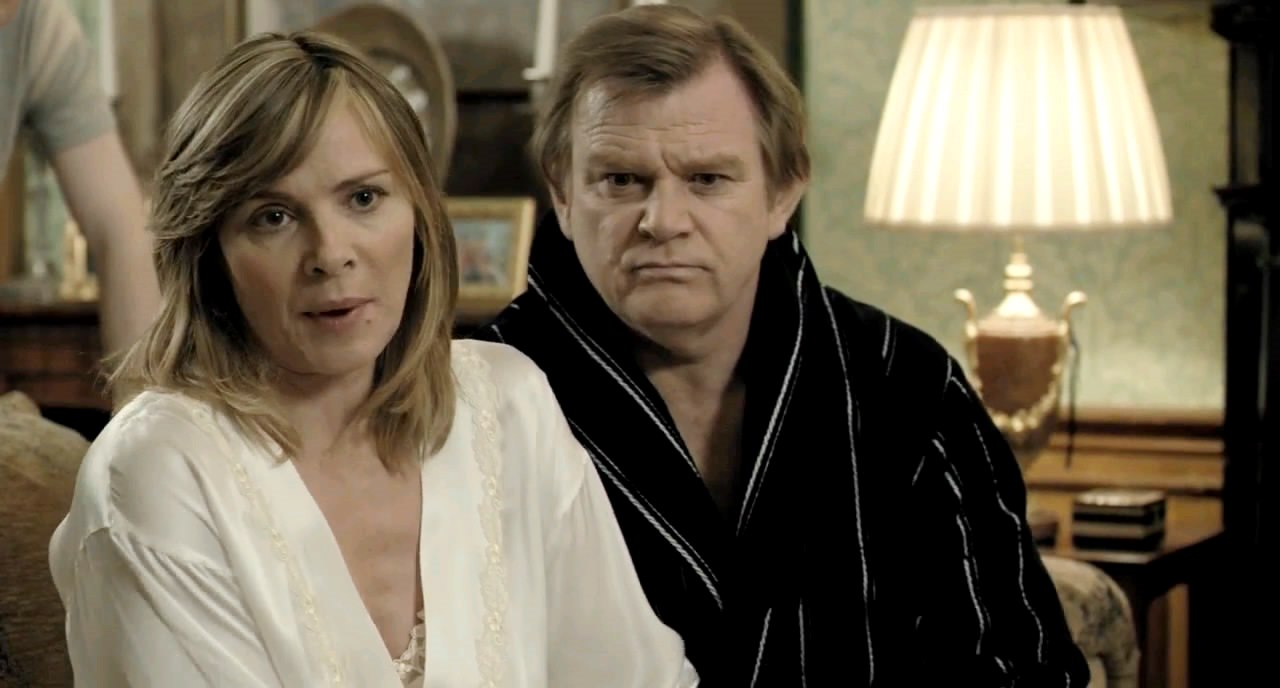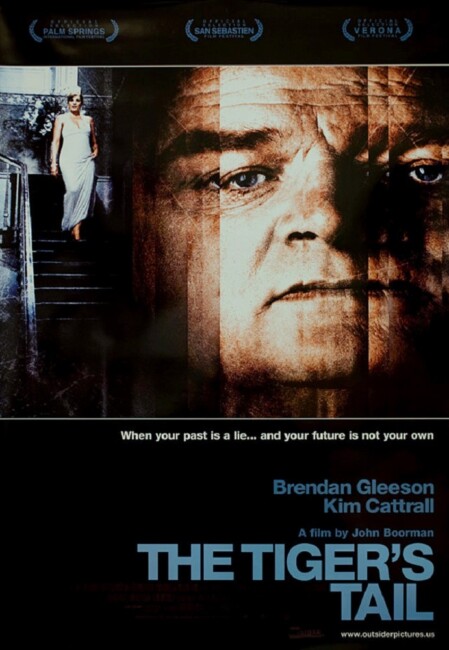Crew
Director/Screenplay – John Boorman, Producers – John Boorman & Kieran Corrigan, Photography – Seamus Deasy, Music – Stephen McKeon, Special Effects Supervisor – Tim Morris, Art Direction – Ian Whittaker. Production Company – UK Film Council/Bord Scannan na hEirann (Irish Film Board)/Merlin Films/Fern Gully Tales/Greengate Productions/Lionside Ltd Productions.
Cast
Brendan Gleeson (Liam O’Leary/The Double), Kim Cattrall (Jane O’Leary), Brian Gleeson (Connor O’Leary), Sinead Cusack (Oona), Ciaran Hinds (Father Andy), Sean McGinley (Declan Murray), Stanley Townsend (Jim Brady), Cathy Belton (Sally Griffin), Moira Deady (Maeve), Ned Dennehy (Felim), Charlene McKenna (Samantha), Angeline Ball (Ursula)
Plot
Liam O’Leary is a successful real estate developer in Dublin. At the same time as he receives a business enterprise award, Liam starts to see a double of himself wherever he goes. He pursues the double, trying to catch him. During one of these pursuits, the double abandons Liam on the moors. The double then returns and takes Liam’s place, having his way with Liam’s wife and then taking over his business. However, when Liam returns home, the double has him arrested and placed in a psychiatric institution. Released, Liam returns, determined to reclaim his life.
John Boorman was one of the great directors to emerge during the 1970s. Boorman first gained attention with films like Point Blank (1967), Hell in the Pacific (1968) and Leo the Last (1972) and then major attention with Deliverance (1972). Throughout this period, Boorman also made a number of genre films with the likes of Zardoz (1974), Exorcist II: The Heretic (1977) and Excalibur (1981), as well as the Magic Realist The Emerald Forest (1985). John Boorman’s genre works are usually his most divided, swinging between brilliance and abject pretension. In more recent years, Boorman is better known for one film he didn’t make – his planned live-action adaptation of The Lord of the Rings during the 1970s.
Since the mid-1990s, John Boorman’s output has been more sporadic but he has still produced a number of excellent works during this period, including the previous Brendan Gleeson collaboration The General (1998), the John Le Carre adaptation The Tailor of Panama (2001) and Country of My Skull/In My Country (2004) about South Africa’s Truth and Reconciliation Commission. In his mid-70s when he made The Tiger’s Tail, Boorman shows no sign of slowing down, having announced two ambitious big-budget films, including Memoirs of Hadrian about the Roman emperor and an animated remake of The Wizard of Oz. The Tiger’s Tail is one of John Boorman’s lesser-regarded films and never attained the widespread arthouse release that his other films of the last decade have.
The Tiger’s Tail sets out to be a doppelganger story along the lines of The Student of Prague (1913 & 1926), the William Wilson segment of Tales of Mystery and Imagination (1968), The Man Who Haunted Himself (1970) and Gemini (1999). In most of these, a doppelganger/evil twin takes over and/or makes a man’s life miserable. The man at the centre of the story is usually seen as some nobly upstanding pillar of success in the community where the doppelganger serves to tear open cracks in the facade of his seemingly perfect life.
The fight between the hero and his double in The Tiger’s Tail is very similar to the same one in Gemini – in both, the hero leads a successful and upstanding life while the double comes from the economically repressed underbelly of society. Here Brendan Gleeson is a top businessman and the double’s appearance serves to expose the cracks in his life – sexually satisfying Gleeson’s wife in the way Gleeson never did, exposing the fragility of his business dealings and reducing the real Gleeson to the poorhouse, even living in a homeless shelter at one point.

The title The Tiger’s Tail is a reference to the term Celtic Tiger, which was coined to describe the economic boom that came about in Ireland in the 1990s/00s. (Though born and raised in London, John Boorman has made his home in Ireland since the 1970s). The metaphor is made clear during Brendan Gleeson’s award speech near the start where he refers to the tail of the [Celtic] Tiger coming up to bite one (something that promptly happened with the 2008 Recession).
The Tiger’s Tail works well. The scenes where the double takes over work with a mixture of humour and Kafka-esque existential horror. Particularly appealing is the quasi-surrealistic opening scene where Brendan Gleeson is caught in a traffic jam on the way home and keeps passing people he knows as they sit in cars alongside the other having phone conversations, amid which he momentarily spots the double as a squeegee washer. The scene is also full of sharp contrasts that illustrate the film’s metaphor of economic disparity – Brendan Gleeson handing a bottle of Mouton Rothschild to a homeless man that comes knocking on his window and returning home to his palatial mansion to face his son quoting Marxist dialectic.
On the minus side, The Tiger’s Tail reaches a more mundane resolution than its doppelganger tale and the strength of its metaphor about the economically repressed coming to haunt the rich suggests. The double inserts itself into Brendan Gleeson’s life without anybody noticing it is not him, which tends to suggest a more fantastic than a realist story. However, John Boorman opts for a mundane resolution where the double is revealed to merely be a twin that Brendan Gleeson never knew about. This strains the basic plausibility of the premise as in actuality no twin can ever get the body language and mannerisms of its sibling down so well as to be able to fool those close to the original. Also, the metaphor of economic division tends to peter out about halfway through and the two Brendan Gleesons come to a convivial agreement to each let the other share parts of their lives (unlike almost any other doppelganger film where it ends up in war between the two for possession of the good twin’s life).
Brendan Gleeson, who has appeared in all of John Boorman’s films since The General, plays with a great bullish strength and holds the film together. He brings his own son Brian with him who plays Liam’s confused Marxism-quoting son. The one piece of eyebrow-raising casting in the film is the presence of Sex and the City (1998-2004) queen Kim Cattrall as Brendan Gleeson’s wife. You are not sure what Kim Cattrall is doing in the film, least of all attempting to put on an Irish accent (even though she is British born). Cattrall is never an actress that has struck one as the character acting type who absorbs themselves inside a role. You cannot help but think she has been cast for star name only, in which case it tends to draw glaring attention to the fact that she is attempting to fabricate an accent that is not naturally her own.

